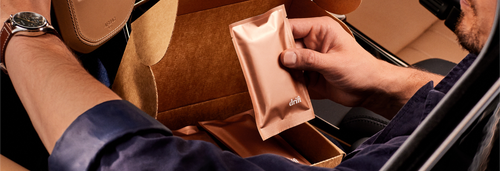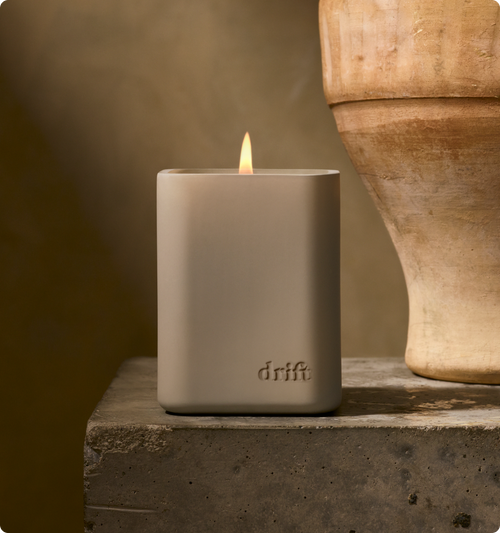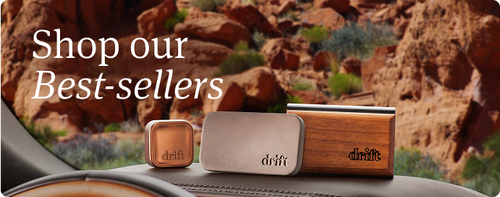
A Tour of the Senses: Take a Whiff of Car Scents History
by Anthony Munaco | 09/03/2024
A Tour of the Senses: Take a Whiff of Car Scents History
“New car smell” is one of the most iconic phrases associated with vehicles, but cars can also produce a myriad of different scents. The pungent reek of gasoline, the saccharine-sweet tang of coolant, and the acrid smell of burning rubber are a few examples that come to mind. Yet we often rely on car fresheners to improve the aroma of our vehicles, a purpose similar to that of perfume and cologne.
The car scents history we often take for granted intertwines with the legacy of the modern vehicle and the millennium-old struggle with personal hygiene. Join us for a journey through time to discover how car scents have evolved since before the automobile was invented. If you want to bring the smells of modernity to your car’s interior, Drift’s many car fresheners offer an elegant and effective solution.
The Timeless Sense of Smell: Perfume’s Origins
Although history has yet to fully illuminate our understanding of how early humans dealt with their natural body odor, evidence dating back to the Egyptians reveals how fragrances first entered our culture. Archaeologists have uncovered tombs of Egyptian pharaohs and priests with fragrances at their side, perhaps to ward off the inferior smell of humanity as they entered the afterlife. The beginnings of perfume have also been associated with a chemist named Tapputi (around 1200 B.C.E.) and Cleopatra in seducing Marc Anthony.
However, it wasn’t until the time of the Romans that perfume gained its name. The word “perfume” comes from the Latin phrase per fumum, meaning “through smoke,” because the Romans would use it to hide the smell of burnt sacrificial offerings. Indeed, it’s said that Rome used several thousand tons of imported frankincense and a few hundred tons of myrrh yearly to mask the odorous stench put off by their rituals.
Pleasant Aromas: A Privilege of the Elite
In the modern world, we have showers and baths to maintain our personal hygiene, but in the Victorian era, only those who belonged to high society could afford such luxuries. It’s theorized that, in 1370, Queen Elizabeth of Hungary inspired the first perfume—aptly named “Queen of Hungary Water”—but perhaps King Louis XIV’s Perfumed Court stands out the most. His Royal Majesty ordered a new scent for each day.
Other prominent historical figures took advantage of the work of chemists during the time, who began to delve into the science of perfumes by extracting various elements. Indeed, Marie Antoinette’s personal perfumer, Jean-Louis Fargeon, likely used this knowledge to his advantage. Napoleon Bonaparte was also rumored to have ordered an exuberant amount of perfume each month.
Interestingly enough, perfumes weren’t governed by trademark law until much later. That meant chemists could experiment with and produce similar smells as one another without fear of reprisal or legal action. Yet, we’re sure the many royal persons mentioned above wouldn’t be too pleased to learn of similarities in their seemingly unique aromas.
The Exotic Crème de la Crème of Personal Hygiene
Fast forward several hundred years to 1921, when Chanel entered the perfume industry. From the early 1900s until the 1970s, many perfumes sold in the United States came from abroad, typically in Europe. These foreign fragrances brought with them a certain exclusivity that continues into the 21st century.
At the same time that personal fragrances were gaining a foothold in homes nationwide, the first automobiles roamed the countryside. Owning a vehicle began as a privilege that naturally paired with expensive perfumes. The stage for the birth of car fragrances was set.
Little Trees: A Turning Point in Car Scents History
Many credit Julius Sämann with the first car freshener, the “Car-Freshner” [sic]. Founder of what would become the Little Trees company, Sämann had an important conversation with a milkman one day, specifically about the sour milk smell that clung to his truck. Struck with the idea to enclose a fragrance in something absorbent that could be hung in the vehicle, Sämann produced the first hanging car air freshener in 1952.
Although the hanging Little Tree we’re most familiar with eventually became the company's shape, the first renditions were actually sealed in cutouts of pin-up models that also adorned the sides of war-bound aircraft. Sämann obtained a patent in 1956, began sending out his Car-Freshners to local gas stations, and impressed cab drivers with the air freshener’s ability to combat foul odors within their vehicles. The iconic pine scent soon prompted a design change, and the Little Trees brand grew from there.
Modern Car Scents: Elevating the Luxury Vehicle Experience
The trajectory of the Little Trees brand somewhat mirrors that of the car fragrance industry as a whole. As vehicles became more popular among the middle class, personalization grew just as quickly. Introducing various scents in the car’s interior helped drivers claim their space and make it feel more like home.
More recently, automotive manufacturers have begun to honor the link between cars and unique scents. For example, Mercedes-Benz offers the Air Balance feature, which purifies and freshens the air entering the cabin for a sophisticated driving experience. The system also introduces multiple fragrances through an atomizer located in the glovebox. Genesis also has its own version of similar technology, with up to three fragrances to choose from.
At the same time, you don’t have to have brand loyalty to Mercedes-Benz or Genesis to enjoy a car ride. Instead, you can purchase car air fresheners to personalize your space. Drift’s Wood, Metal, and Stone air fresheners are premium examples of how car scents history has evolved. Choose from scents like amber, cabana, grove, and teak to set the tone for your next commute, regardless of the car you drive.
Drift Premium Car Scents: Make Your Own History
It doesn’t take a history lesson to appreciate that we can easily customize our vehicles with premier car scents, but it does offer perspective. Drift offers drivers a unique experience behind the wheel with our deluxe scents. Take our Scent Quiz to find your next favorite car freshener, or subscribe to our Scent of the Month program for the thrill of a new scent each month.






